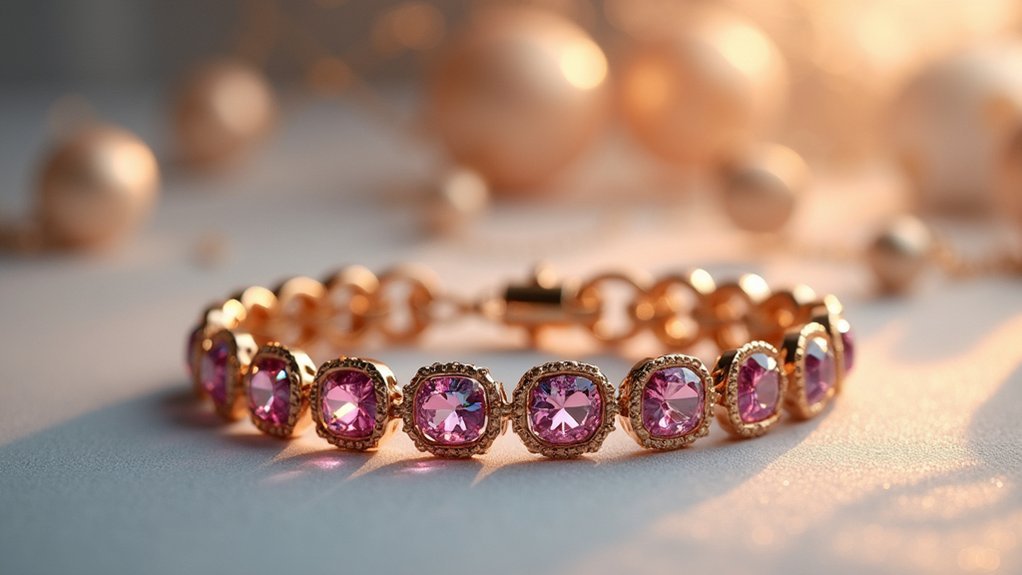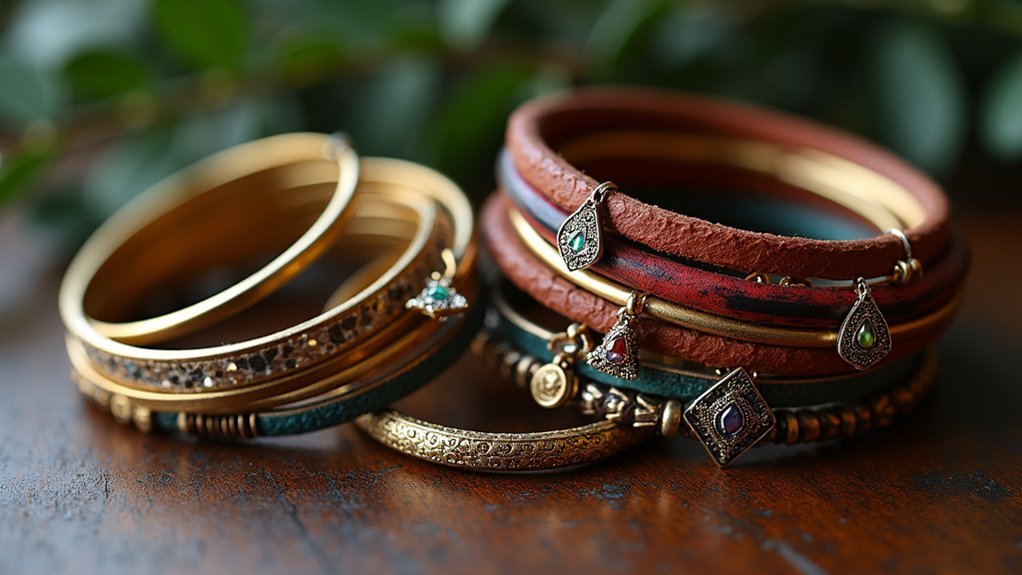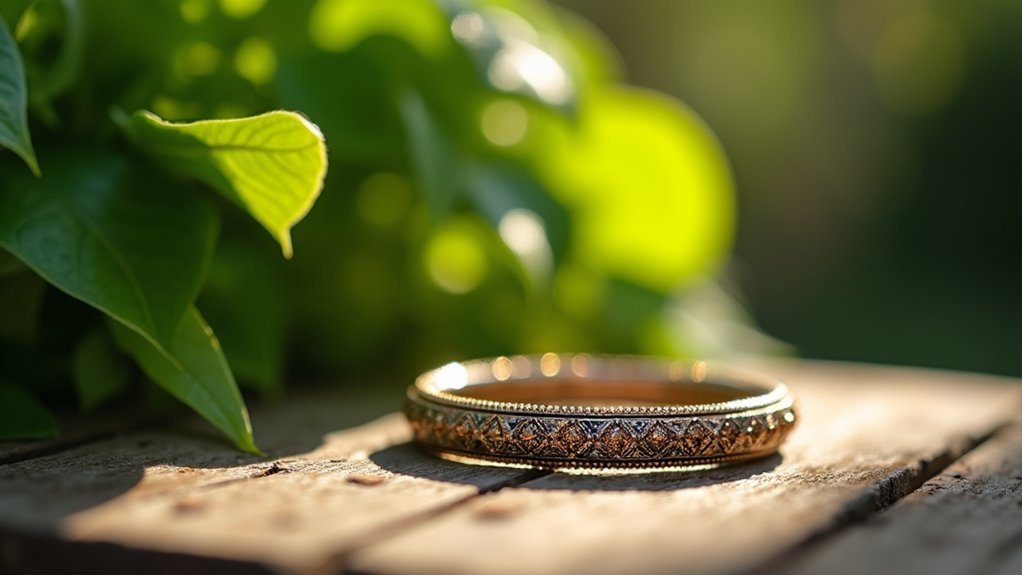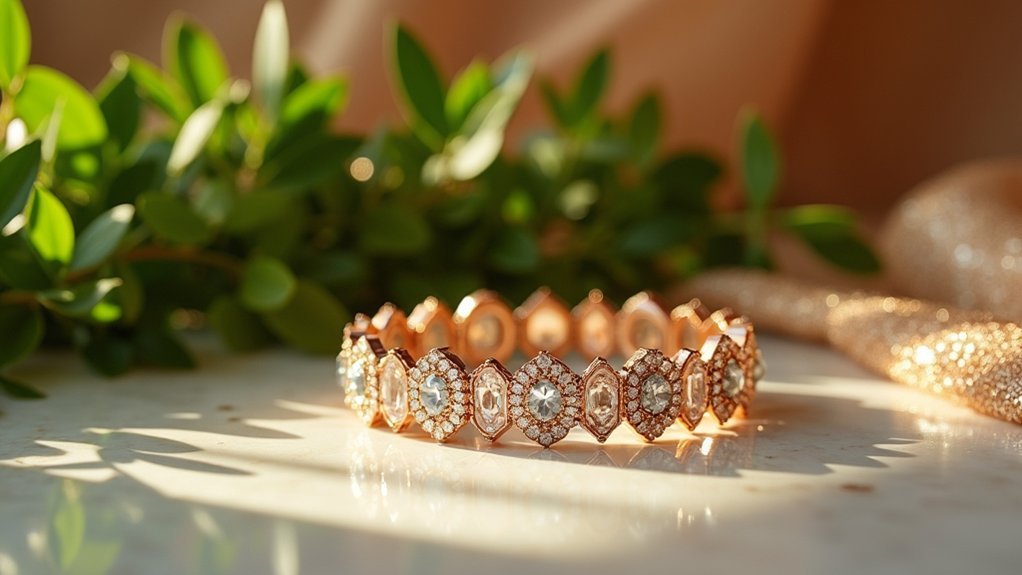Start with neutral backgrounds like white or light gray to maintain professionalism, then experiment with textured surfaces such as wood or marble for added luxury. Position lighting at a 45-degree angle to capture intricate details, and use macro lenses to showcase gemstones and textures. Incorporate natural elements like leaves or stones for organic beauty, and master stacking techniques by varying widths and materials for dynamic contrast. Utilize reflective surfaces and capture genuine lifestyle moments that tell your bracelet’s story—these foundational techniques will reveal even more advanced styling secrets.
Master the Art of Background Selection for Bracelet Photography

When photographing bracelets, your background choice can make or break the entire image. Neutral backgrounds like white or light gray guarantee your jewelry maintains a professional appearance while remaining the focal point.
You’ll enhance visual appeal by incorporating textured surfaces such as wood, marble, or velvet, which add depth and luxury to your composition.
For dramatic effects, utilize reflective surfaces like glass or mirrors to highlight intricate bracelet details.
When creating lifestyle shots, match backgrounds to your bracelet’s intended context—natural settings work for casual pieces, while elegant environments suit high-end jewelry.
Maintaining consistency in background selection for bracelet photography builds cohesive images that strengthen brand identity, helping customers recognize and trust your jewelry line.
Create Visual Drama Through Strategic Lighting Techniques
You can transform your bracelet photography from ordinary to extraordinary by mastering strategic lighting techniques that create engaging visual drama.
Spotlight effects will help you direct the viewer’s attention exactly where you want it, while controlled reflections add depth without overwhelming your subject.
These lighting approaches work together to elevate your bracelet shots into enchanting images that command attention and showcase luxury.
Dramatic Spotlight Effects
How can a single beam of light transform an ordinary bracelet photograph into a stunning work of art?
You’ll create dramatic shadows and specular highlights by positioning your lighting at a 45-degree angle to your bracelet. This technique produces exceptional depth while making intricate details pop against contrasting backgrounds.
These photography tips will help you achieve high-quality images that captivate viewers.
Experiment with colored gels to introduce mood and emphasize your bracelet’s unique materials.
Strategic reflectors bounce light back, reducing harsh shadows while maintaining visual drama.
Control your light’s intensity and distance carefully—you don’t want overexposure ruining your shot.
The key is balancing dramatic effect with proper exposure, ensuring every texture and detail remains crisp and compelling in your final image.
Controlling Reflections Strategically
While reflections can make or break your bracelet photography, mastering their control transforms metallic surfaces into powerful compositional tools.
You’ll want to use soft lighting that minimizes harsh glare while preserving intricate details. Experiment with your camera and light source angles to achieve balanced reflections that won’t overwhelm your jewelry’s features.
Strategic lighting involves incorporating reflective surfaces like glass or polished backgrounds to enhance visual depth and drama. Control strength by adjusting the distance between your bracelet and these surfaces—closer creates stronger reflections, while farther produces subtler effects.
Don’t forget shadow play’s importance in adding dimension. These lighting techniques create contrast that emphasizes your bracelet’s beauty, ensuring reflections work for you rather than against your composition.
Showcase Bracelet Details With Thoughtful Composition and Angles

Since capturing a bracelet’s true beauty requires strategic positioning and precise framing, mastering composition becomes essential for creating engaging jewelry photographs.
Use a macro lens to capture intricate bracelet details like gemstones, engravings, and textures with stunning clarity. Experiment with different angles—try 45-degree tilts or straight-on shots to find the most flattering perspective that showcases craftsmanship effectively.
Master the art of macro photography by experimenting with strategic angles that reveal every exquisite detail of your bracelet’s unique craftsmanship.
Implement stacking techniques by layering multiple bracelets with varying widths and textures, creating rich visual appeal while maintaining compositional balance.
Choose clean backgrounds that complement your bracelet’s colors and style, ensuring the piece remains the focal point. Apply soft lighting to minimize harsh shadows and unwanted reflections, enhancing the bracelet’s shine and highlight features that make each piece unique and enthralling.
Enhance Your Shots With Natural Elements and Textured Props
You’ll transform ordinary bracelet photos into enchanting images by incorporating natural elements like leaves, flowers, or stones that create organic beauty and harmony.
Textured surfaces such as wood, marble, or velvet backgrounds will enhance your jewelry’s luxury appeal while providing visual interest that keeps the bracelet as your focal point.
These thoughtful additions won’t overwhelm your composition—instead, they’ll complement your bracelet’s intricate details and add emotional depth that resonates with potential customers.
Natural Element Integration
Although digital perfection dominates modern photography, there’s something undeniably enchanting about integrating natural elements into your bracelet shots.
You’ll discover that organic beauty emerges when combining jewelry with nature’s offerings, creating powerful visual storytelling that resonates deeply with viewers.
Consider these natural integration approaches:
- Seasonal elements: Incorporate autumn leaves or spring blossoms as seasonal props to evoke specific emotions and create timely, relatable content.
- Textured surfaces: Use wood, marble, or stone to provide depth and contrast while maintaining focus on your bracelet.
- Natural light positioning: Leverage soft shadows and highlights to create an authentic image that feels genuine rather than overly staged.
Through creativity and experimentation with these elements, you’ll craft unique compositions that transform ordinary product shots into compelling narratives that captivate your audience.
Textured Surface Selection
Soft props serve dual purposes in your photography setup. They naturally diffuse harsh light while creating gentle shadows that enhance bracelet details. Velvet particularly excels at light diffusion, eliminating unwanted reflections that distract from your subject.
Experiment boldly with contrasting textures to generate visual interest. A weathered wooden surface against polished gold creates dynamic tension, while naturally textured backgrounds help color highlight your bracelet’s unique design elements and materials effectively.
Perfect the Stack: Layering Multiple Bracelets for Dynamic Impact

Mastery of bracelet stacking transforms a single accessory into a charming focal point that commands attention in your photographs.
Creating distinctive pieces requires strategic planning for maximum visual interest.
When layering bracelets, you’ll achieve a balanced arrangement by focusing on these essential elements:
- Vary widths and textures – Mix metal, leather, and beads to enhance overall aesthetic through dynamic contrast
- Choose complementary colors – Select harmonious patterns that showcase each bracelet product individually while maintaining cohesion
- Adjust lengths strategically – Prevent overcrowding by varying bracelet sizes, allowing each piece to shine
Photographing layered bracelets demands careful attention to negative space.
You’ll avoid cluttered compositions by positioning stacked bracelets thoughtfully, ensuring viewers can appreciate each piece’s craftsmanship and design details.
Utilize Reflections and Shadows to Add Depth and Dimension
When light interacts with reflective surfaces, you’ll discover powerful techniques that elevate your bracelet photography from flat documentation to compelling visual storytelling.
Use polished surfaces like glass or mirrors to create subtle reflections that add depth and dimension without overwhelming your subject. Adjust lighting angles carefully to cast soft shadows that naturally frame the bracelet, enhancing visual interest while highlighting essential bracelet features.
Polished surfaces create dimensional reflections while strategic lighting angles cast soft, framing shadows that highlight bracelet details without overpowering the subject.
Experiment with varying reflection strengths to find the perfect balance between clarity and artistic appeal. Strategic shadows create layering that’ll engage viewer attention and provide compelling composition.
A light tent diffuses harsh lighting, ensuring reflections appear complementary rather than distracting. These controlled elements work together, transforming simple product shots into sophisticated imagery that captures your bracelet’s unique character and draws viewers into the visual narrative you’re creating.
Capture Lifestyle Moments That Tell Your Bracelet’s Story

Beyond studio setups, lifestyle photography transforms your bracelet from a simple accessory into a meaningful part of someone’s daily story.
You’ll create an emotional connection with your target audience by showcasing how your piece naturally fits into real-life moments. Natural light enhances visual appeal while revealing authentic interactions between wearer and jewelry.
Your storytelling approach should include:
- Varied settings – Experiment with outdoor environments and cozy indoor spaces to demonstrate your bracelet’s versatility across different occasions and moods.
- Curated props – Include coffee cups, books, or fashion accessories that resonate with your audience’s lifestyle and interests.
- Candid moments – Capture genuine expressions of joy and confidence that emphasize how the bracelet becomes part of the wearer’s identity.
Frequently Asked Questions
How to Take a Good Photo of a Bracelet?
Use a macro lens with natural lighting on a clean, neutral background. You’ll want to experiment with different angles while minimizing harsh shadows. Include subtle props that complement without overwhelming your bracelet’s design.
What Camera Settings Are Best for Jewelry Photography?
Set your camera to ISO 100-400, aperture f/8-f/16, and shutter speed 1/125s or faster. Use manual focus for reflective surfaces and adjust white balance to 5000K-6000K for accurate colors.
How to Make Jewelry Sparkle in Photography?
You’ll maximize jewelry sparkle by using soft, diffused lighting at multiple angles. Clean pieces thoroughly with microfiber cloth, employ macro lenses for detail, and position reflective surfaces underneath to amplify brilliance and create stunning depth.
How to Photograph Jewelry Without Glare?
You’ll eliminate glare by using soft, diffused lighting and positioning jewelry at slight angles. Try polarizing filters, matte backgrounds that absorb light, and adjust your shooting distance to find ideal perspectives without harsh reflections.
In Summary
You’ve now got seven powerful techniques to transform your bracelet photography from ordinary to extraordinary. Don’t be afraid to experiment with different combinations of these styling tips—mix dramatic lighting with natural textures, or combine lifestyle shots with strategic reflections. Remember, the best bracelet photos tell a story while showcasing every beautiful detail. Practice these methods consistently, and you’ll develop your unique photographic style that makes your jewelry irresistible to viewers.





Leave a Reply